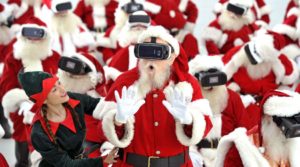2016 – the year of VR and AR
 The power and potential of AR was perhaps epitomized by the debut of Pokémon Go, a classic Japanese video game reimagined as an AR experience on a smartphone screen, sending legions of gamers around the world trekking through parks and alleys — real ones! — for imaginary monsters. Now just imagine those imaginary monsters are instead floating, three-dimensional historical figures embedded with factoids for tourists, or coupons for deals at local Starbucks or Best Buy stores and then the potential of AR over VR becomes obvious.
The power and potential of AR was perhaps epitomized by the debut of Pokémon Go, a classic Japanese video game reimagined as an AR experience on a smartphone screen, sending legions of gamers around the world trekking through parks and alleys — real ones! — for imaginary monsters. Now just imagine those imaginary monsters are instead floating, three-dimensional historical figures embedded with factoids for tourists, or coupons for deals at local Starbucks or Best Buy stores and then the potential of AR over VR becomes obvious.
A less faddish example of AR's potential is Snapchat Lenses feature, which debuted in 2015. Allowing anyone to instantly have a new, expressive face mapped onto their own, which moves as they move in the real world, Lensesare just the tip of the AR iceberg.
Meanwhile, in the background, the massively funded and super-secretive Magic Leap continues to lurk, with few having sampled what the company describes as a kind of mix of VR and AR. But despite the funding and the skunkworks hype, until the public meets the product, it's just a cool idea that has yet to prove its worth.
VR and AR are still infant technologies, but the vision behind them is more clear: Reality will slowly melt away and give way to "mixed reality," a new, tech-powered Disney-like world in which nearly every surface, object and location becomes an animated interface delivering digital magic in just about every corner of the planet.
The company recently posted a job looking for "an expert in producing 3D character and props animation," signaling that Snapchat, aided by wearable cameras in the form of Spectacles, may soon be populated by a vast array of virtual characters layered on top of real life.
See the full story here: http://mashable.com/2016/12/07/year-of-vr-augmented-reality/#RRT5lX.XjOq2
Pages
- About Philip Lelyveld
- Mark and Addie Lelyveld Biographies
- Presentations and articles
- Tufts Alumni Bio